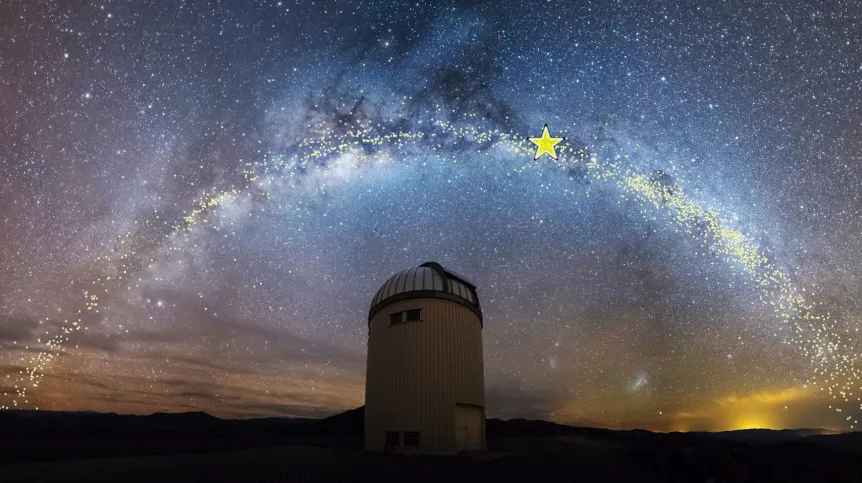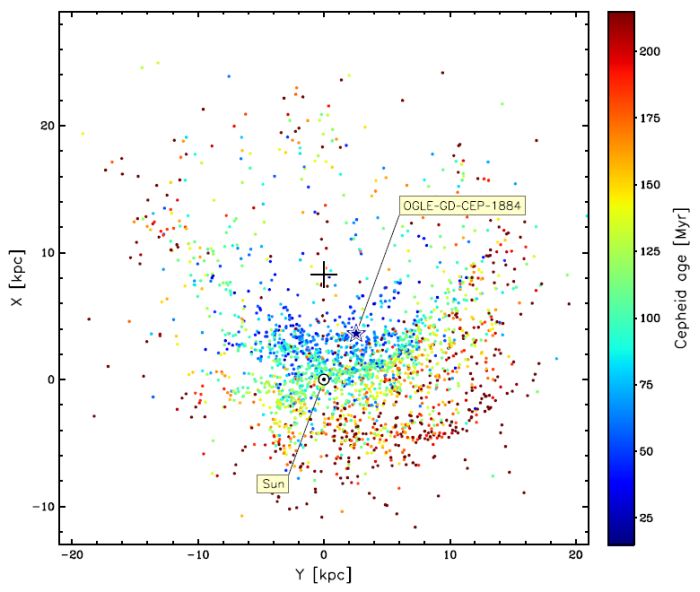
Astronomers from the Astronomical Observatory at the University of Warsaw have discovered a massive variable star, i.e. a classical Cepheid, with the longest pulsation period in our galaxy. According to researchers, it is not only the brightest, but also probably the youngest known classical Cepheid in the Milky Way. It is 22 million years old.
he newly identified star was selected by Professor Igor Soszyński, the world leader in research on variable stars, and received the catalogue number OGLE-GD-CEP-1884. It pulsates with a period of 78.14 days, which is almost 10 days longer than the pulsation period of the previous record holder, the Cepheid S Vulpeculae, the Astronomical Observatory of the University of Warsaw reports in a press release.
The discovery was made by scientists working in the OGLE project conducted at the Observatory.
The OGLE research team, led by Professor Andrzej Udalski, has extensive experience in discovering and studying pulsating stars. Approximately half of all classical Cepheids currently known in the Milky Way were discovered by Warsaw astronomers.
A few years ago, researchers led by Professor Dorota Skowron published a three-dimensional map of the galaxy obtained on the basis of the spatial distribution of Cepheids discovered by the OGLE team. This map clearly showed that the disk of the Milky Way was not flat, but bent into an S-shape.

Classical Cepheids are massive variable stars that have found extremely important astrophysical applications. In 1924, American astronomer Edwin Hubble used the period-luminosity relation of Cepheids to prove that the Universe consisted of an innumerable number of galaxies and not, as previously thought, only the Milky Way. A few years later, Cepheids observed in neighbouring galaxies helped Hubble discover the fact that the Universe was expanding, which soon led to the formulation of the Big Bang theory.
Today, classical Cepheids are widely used to measure intergalactic distances and study the structure of galaxies. Among other things, Cepheids are the basis for the most accurate measurement of the Hubble constant, a quantity that determines the rate of expansion of the Universe.
The newly discovered star OGLE-GD-CEP-1884 belongs to a small group of Cepheids with extremely long pulsation periods (ultra-long-period Cepheids, ULPC). A feature of this type of objects - as the astronomers from the University of Warsaw explain - is their high brightness, which is used to measure the distance to galaxies located up to 300 million light years from us.
'So far, not a single ULPC-type object has been known in our Galaxy, although most of the studied galaxies contain several Cepheids of this type. Despite the fact that OGLE-GD-CEP-1884 is over 25,000 times brighter than the Sun, it has not been correctly classified before as a Cepheid because it is located behind a thick layer of interstellar matter that absorbs light from the object, especially in the blue part of the spectrum,’ the scientists say.
Many years of photometric observations of this star in red light conducted by the OGLE team, combined with radial velocity measurements made by the Gaia space telescope, made it possible to clearly demonstrate that OGLE-GD-CEP-1884 was a classical Cepheid.
'The discovery of OGLE-GD-CEP-1884 suggests that ULP Cepheids are also present in our Galaxy, probably in the regions strongly affected by interstellar extinction. This finding underscores the need for current and future sky surveys to adopt more efficient methods of detecting and classifying variable stars,’ the scientists say.
OGLE-GD-CEP-1884 is not only the brightest, but also probably the youngest known classical Cepheid in the Milky Way. The age of this star was estimated at 22 million years.

According to the researchers, by using the period-luminosity relation for Cepheids, it was possible to measure the distance to OGLE-GD-CEP-1884 and mark its location on the map of our galaxy. This star is located 14,500 light-years away in the spiral Norma Arm, among other relatively young classical Cepheids. The discovery of OGLE-GD-CEP-1884 will contribute to a more accurate calibration of the period-luminosity relation for Cepheids and to a better understanding of the evolution of massive stars.
The paper presenting the discovery of the classical Cepheid with the longest pulsation period was published in The Astrophysical Journal Letters (https://doi.org/10.3847/2041-8213/ad392f). (PAP)
PAP - Science in Poland
agt/ bar/ kap
tr. RL













